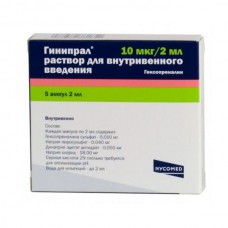Expiration date: 11/2026
The composition and form of issue:
The intravenous solution 10 mg/2 ml 1 amp. (2 ml)
hexoprenaline sulfate 0.01 mg
sodium metabisulfite 0.04 mg
disodium edetate dihydrate 0.05 mg
sodium chloride 18 mg
sulfuric acid 2N — q.s. to optimize pH
water for injection to 2 ml
in a contour acheikova package 5 ampoules of colorless glass with the point of the fault in the paper cartons 1 or 5 packs.
Description pharmaceutical form:
Solution for injection: clear, colorless solution.
Pharmacokinetics:
Ginipral consists of 2 groups of catecholamine, which in the human body undergo methylation by catecholamine-O-methyltransferase. Hexoprenaline becomes biologically inactive only in the case of methylation of both their groups of catecholamine.
Studies with 3H-labeled substances, conducted on rats, showed that when using hexoprenaline during the first 4 h, 80% of biologically active substances allocated with urine in an unmodified form, i.e. in the form of free and hexoprenaline monomethilaniline. Subsequently, increased excretion of demetilirovania and related compounds (glucuronide and sulfate).
Description pharmacological action:
Relaxes the muscles of the uterus, it reduces the frequency and intensity of contractions, inhibits spontaneous and oxytocin-induced contractions. During childbirth normalizes the strength and regularity of contractions, inhibits (in most cases) premature contractions and contributes to the prolongation of gestation to normal term delivery. Slightly acts on the cardiovascular system of the pregnant woman and the fetus.
Indications:
Solution for injection
Acute tocols:
inhibition of generic contractions during labor when acute intrauterine asphyxia
immobilization of the uterus before the caesarean section, before turning the fetus from a transverse position, when prolapse of the umbilical cord in complicated labor
as an emergency measure when preterm labour before delivering a pregnant hospital.
Massive tocols
the inhibition of premature labour in the presence of smoothed the cervix and/or disclosure of the cervix.
Long tocols
prevention of preterm delivery in the amplification or increase in the frequency of contractions in the absence of shortening of the cervix, or opening of cervix
immobilization of the uterus before, during and after cervical cerclage.
Contraindications:
- hypersensitivity (especially in patients with bronchial asthma with hypersensitivity to sulphites)
- thyrotoxicosis
- cardiovascular diseases, especially arrhythmias, occurring with tachycardia, myocarditis, mitral valve disease and aortic stenosis
- CAD
- hypertension
- severe liver disease and kidney
- angle-closure glaucoma
- premature detachment of the placenta, uterine bleeding, intrauterine infection
- pregnancy (I trimester)
- lactation.
Application of pregnancy and breast-feeding:
Contraindicated in the first trimester of pregnancy. At the time of treatment should stop breastfeeding.
Side effects:
Headache, anxiety, tremor, sweating, tachycardia (minor — pregnant women, fetus — rare), swelling, dizziness, in rare cases, nausea and vomiting.
In patients with asthma and in patients with hypersensitivity to sulfites, receiving Ginipral may cause an allergic reaction (shortness of breath, impaired and loss of consciousness, bronchospasm, anaphylactic shock).
Possible decrease in blood pressure, especially diastolic. In rare cases, ventricular extrasystoles, pain in region of heart (cardialgia). These symptoms quickly disappear after drug discontinuation.
Glikogenoliticski effect is increased blood sugar, diabetes, this effect is more pronounced.
Diuresis, especially at the beginning of treatment, is reduced.
Hypokalemia, hypocalcemia — in the beginning of therapy, but in the process of further treatment of potassium and calcium normalized. May be a temporary increase in transaminaz in the serum. It may be inhibition of intestinal motility. In rare cases, intestinal atony, so when tocolytic therapy should pay attention to the regularity of the chair.
In newborns, hypoglycemia, acidosis, bronchospasm, anaphylactic shock.
Drug interactions:
Effect reduce (partially or completely) non-selective &beta-blockers, increase — methylxanthines (theophylline).
Funds for General anesthesia (halothane) and agonists (some of the cardiovascular and Antiasthmatic funds) increased side effects from cardiovascular system.
Reduces the accumulation of glycogen in the liver under the influence of glucocorticoids.
Ginipral incompatible with the ergot alkaloid, MAO inhibitors, tricyclic antidepressants, and mineralocorticoids, digidrotahisterola and preparations containing calcium and vitamin D.
Sulfite is vasoactive component, therefore, should refrain from mixing Ginipral with other solutions, except izotoniceski solution of sodium chloride and 5% glucose solution.
Method of application and dose:
In/in (bolus or infusion).
The contents of the vial must be entered in/in slowly (over 5-10 min) with the use of automatically dispensing the infusion pumps or with conventional infusion systems after dilution with isotonic sodium chloride solution to 10 ml.
The handling of the ampoule shown below:
1. Keep a vial of colored mark up.
2. Shake off the liquid from the top of the vial down.
3. To break off the end of the ampoule at the point of fault.
Dosage
1. Acute tocols. 10 mcg (1 ILA. 2 ml). Further, if necessary, treatment can be continued using the infusion.
2. Massive tocols. At the beginning of treatment starts with the introduction of 10 mcg (1 ILA. 2 ml), followed by infusion Giniprala at a speed of 0.3 ág/min as an alternative treatment is possible to use only infusion Giniprala at a speed of 0.3 ág/min, without prior bolus injection.
3. Long tocols. Prolonged drip infusion of 0.075 mcg/min.
If within 48 h is not going on the resumption of contractions, treatment can be continued with tablets Giniprala 0.5 mg ( see relevant application manual).
This dose can be used only as a rough estimate, when Togolese must be adjusted individually.
Overdose:
Symptoms:a significant increase in heart rate in the mother, the occurrence of tremor, severe tachycardia, headaches, increased perspiration, anxiety, cardialgia, shortness of breath.
Treatment: the use of antagonists Ginipral — non-selective &beta-blockers.
Special instructions:
During the application Ginipral should monitor the pulse and blood pressure of the mother and a fetal heartbeat.
It is recommended to record the ECG before and during treatment.
Patients with hypersensitivity to sympathomimetics should be used Ginipral small dose set individually, under the constant supervision of a physician.
With a significant increase in heart rate in the mother (more than 130 beats/min) and expressed lower AD should reduce the dose if you have complaints about shortness of breath, pain in the heart and when signs of heart failure use of Ginipral should cease immediately.
In pregnant women with diabetes, should monitor the carbohydrate metabolism, since the use of Ginipral (especially in the early stages of treatment) can cause an increase in blood sugar. If the birth takes place directly after the course of treatment, it is necessary to consider the possibility of neonates with hypoglycemia and acidosis due transplatzentarnogo penetration of acidic metabolic products (dairy and ketone acids).
In some cases, simultaneous use of corticosteroids during the infusion Giniprala can cause pulmonary edema. Therefore, infusion therapy must be continued careful clinical monitoring of patients. This is especially important in the combined treatment of corticosteroids in patients with concomitant diseases contributing to fluid retention (kidney diseases).
Must strictly limit the excess fluid intake.
The risk of development of pulmonary edema requires the restriction of the volume of the infusion as possible and also use for dilution of the drug solutions containing no electrolytes.
Must limit the intake of salt with food.
Before starting tocolytic therapy should take potassium supplements, because if hypokalemia sympathomimetic effect on the myocardium increases.
The simultaneous use of some drugs (halothane) and sympathomimetics can cause heart rhythm disorders. Receiving Ginipral must stop before using halothane for anesthesia.
With prolonged tocolytic therapy to monitor the status of fetoplacental complex, to ensure no detachment of the placenta. Clinical symptoms of premature detachment of the placenta can be smoothed on the background of tocolytic therapy. When rupture of membranes and the cervical dilatation of more than 2-3 cm, the effectiveness of tocolytic therapy is a small.
In the process of tocolytic treatment is necessary to control bowel movements.
During tocolytic treatment with the use of beta-agonists can intensify the symptoms related dystrophic myotonia. In such cases, the use of drugs diphenylhydantoin.
Coffee and tea can strengthen the side effects Giniprala.


